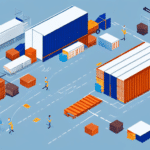Streamlining Logistics with Unit Load Devices (ULDs)
As the transportation industry continues to evolve, businesses are constantly seeking new ways to streamline their logistics operations and reduce costs. One innovative solution that has proven to be highly effective in achieving these goals is the use of Unit Load Devices (ULDs) in logistics. In this article, we will explore the different ways in which ULDs are being utilized by businesses around the world and examine the numerous benefits that come with incorporating these devices into your own supply chain management practices.
Understanding Unit Load Devices (ULDs)
What Are ULDs?
Put simply, a Unit Load Device (ULD) is a container designed specifically for transporting cargo in the most efficient manner possible. By packing and securing goods within a ULD, businesses can reduce the time and effort required to handle individual pieces of freight, as well as minimize the risk of damage or loss during transit. ULDs are used primarily in the airline industry, where they can quickly and easily be loaded onto commercial and cargo planes, but they are also utilized in other forms of transportation, such as on container ships or trucks.
How Do ULDs Work?
Each ULD is assigned a unique identification number, enabling real-time tracking and monitoring throughout the entire transportation process. This level of visibility and control is essential for businesses that need to ensure the safe and timely delivery of their goods.
Environmental Benefits
In addition to their efficiency and security benefits, ULDs are environmentally friendly. By using ULDs to transport goods, businesses can reduce the amount of packaging materials and waste generated during the shipping process. This not only helps to reduce the environmental impact of logistics operations but can also lead to cost savings by minimizing the need for additional packaging materials.
The Evolution and Types of ULDs
The History of ULDs
The use of ULDs dates back to the 1950s when the airline industry began exploring ways to streamline the loading and unloading of cargo onto planes. Prior to the widespread adoption of ULDs, cargo had to be handled manually, which was time-consuming and often resulted in damage. The introduction of ULDs allowed for more efficient operations and reduced ground time for aircraft.
Different Types of ULDs
There are several types of ULDs, each designed to meet specific logistical needs:
- LD3 Containers: Designed to fit in the lower deck of most commercial aircraft and can hold up to 1,000 kilograms of cargo.
- LD9 Containers: Larger than LD3s, capable of holding up to 4,500 kilograms of cargo.
- LD7 Pallets: Suitable for oversized cargo, these pallets can be loaded onto the main deck of most commercial aircraft.
- LD11 Containers: Smaller than LD3s, commonly used for shipping express mail and other small packages.
Additionally, specialized ULDs are available for specific types of cargo, such as refrigerated ULDs for perishable goods and ULDs designed for transporting live animals, often equipped with temperature control systems and ventilation.
Cost Savings and Efficiency Benefits
Reducing Labor and Handling Costs
One of the key advantages of using ULDs is the significant cost savings associated with reduced handling. By consolidating cargo into ULDs, businesses can decrease the number of individual packages that need to be managed, leading to lower labor costs and faster turnaround times.
Optimizing Transportation Costs
ULDs are engineered to maximize the use of available space in cargo planes and trucks, allowing for more cargo to be transported in a single trip. This optimization reduces the number of trips required, thereby lowering transportation costs. Additionally, the reusable and durable nature of ULDs means that businesses can save money on packaging materials and reduce waste.
Enhancing Supply Chain Efficiency
ULDs improve efficiency by enabling faster loading and unloading processes, which minimizes downtime and accelerates the delivery of goods. The standardized design of ULDs also facilitates smoother integration across different transportation modes, enhancing overall supply chain productivity.
Environmental Impact of ULDs
Reducing Carbon Footprint
By optimizing space and reducing the number of shipments needed, ULDs help lower the carbon footprint of logistics operations. Fewer trips mean fewer emissions from trucks, planes, and ships, contributing to a more sustainable transportation process.
Sustainable Practices
The reusable and recyclable nature of ULDs supports sustainable business practices by minimizing waste and promoting the use of eco-friendly materials in logistics operations.
Future Trends in ULD Technology
Advancements in Materials and Design
As technology advances, ULDs are expected to become even more efficient and sustainable. Innovations in materials science and design are leading to lighter, more durable ULDs that can handle greater capacities while reducing environmental impact.
Integration with Smart Technologies
Future ULDs may incorporate smart technologies such as IoT sensors for real-time monitoring of temperature, humidity, and shock levels. This data can enhance cargo safety and provide valuable insights for supply chain optimization.
Increased Adoption Across Industries
While ULDs are predominantly used in the airline industry, their adoption is expanding into other sectors such as maritime and road transport, driven by the need for greater efficiency and sustainability in logistics operations.
Best Practices for Implementing ULD Systems
Choosing the Right ULD
When selecting ULDs, consider factors such as the size and weight of your cargo, the types of transportation used, and specific operational requirements. Collaborating with logistics experts or ULD manufacturers can help identify the most suitable containers or pallets for your needs.
Overcoming Implementation Challenges
Implementing ULD systems may require investment in additional equipment or infrastructure and adjustments to packing processes. These challenges can be addressed through careful planning, employee training, and ongoing support to ensure successful integration.
Maintaining ULD Inventory
Regular maintenance and inspection of ULDs are crucial to ensure their functionality and safety. Establish procedures for routine checks, maintenance, and the repair or replacement of damaged ULDs to maintain the efficiency and reliability of your logistics operations.
Conclusion
Overall, the use of ULDs in logistics offers a wide range of benefits for businesses aiming to streamline their supply chain management and reduce costs. From increased efficiency and productivity to enhanced safety and environmental sustainability, ULDs provide a reliable and cost-effective solution for transporting cargo. By carefully evaluating your logistics needs and selecting the appropriate ULDs, businesses can achieve significant cost savings and gain a competitive edge in the marketplace.




















